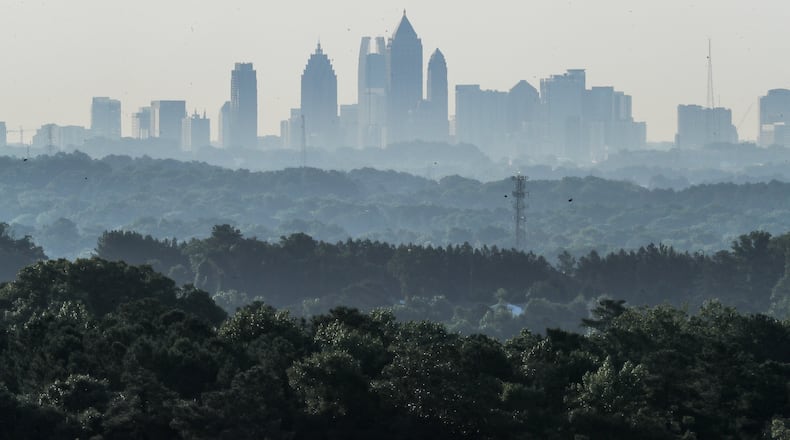Environmental regulators have decided to set a tighter standard for a tiny, but insidious class of air pollution particles linked to serious illnesses and thousands of premature deaths.
The federal Environmental Protection Agency (EPA) and health experts say the rule will save lives and yield billions of dollars in savings. But Georgia Environmental Protection Division (EPD) leaders say it will be difficult for parts of the state to comply, and along with manufacturing interest groups, claim the new limits could stifle economic growth.
The new rule finalized last week is for a type of pollutant known as particulate matter 2.5, or PM2.5. The change to the standard is the first in more than a decade, after the EPA under former President Donald Trump kept previous limits in place.
Here’s what you need to know.
What is PM2.5?
PM2.5 are ultra-fine pollution particles measuring 2.5 micrometers or less in diameter. That’s about 30 times smaller than the width of a human hair.
The pollution comes from many sources: Car tailpipes, coal-fired power plants and manufacturing that involves combustion. The wear and tear of vehicle tires and brakes also produces PM2.5, as do fires and yard work, like leaf blowing.
Credit: Jason Getz/AJC
Credit: Jason Getz/AJC
The particles’ microscopic size allows them to penetrate the body’s defenses, making them particularly dangerous.
“Whereas larger particles tend to get caught in your mouth, your nose, things like that ... PM2.5 is more problematic because it’s small enough to go deep into your lungs,” said Rodney Weber, a professor in Georgia Tech’s School of Earth and Atmospheric Sciences.
Health effects
The particles have also been linked to serious health problems, especially heart and respiratory issues. The World Health Organization estimates as many 4.2 million premature deaths each year globally are caused by all types of outdoor air pollution.
For years, research has tied PM2.5 exposure to heart attacks and irregular heartbeats, as well as lung disease, asthma and breathing issues. More recently, the particles have been linked to strokes and neurological disorders, like dementia. Maternal exposure is also associated with lower birthweights.
Children, the elderly and those with pre-existing conditions are most at-risk, while studies have shown lower-income areas and communities of color are more likely to breathe dirty air. In Georgia, nearly 9% of children have asthma, with Black children, especially boys, most likely to have the disease.
What changed?
The EPA lowered the annual PM2.5 standard from 12 micrograms per cubic meter (µg/m3) down to nine. The annual value is an average of all data collected by an area’s air monitors in a year.
The agency says it expects the change will help prevent 4,500 premature deaths, 800,000 cases of asthma and 290,000 days of lost productivity once it is fully implemented in 2032. In all, the agency estimates improvements in air quality will bring the country $46 billion in net health benefits.
“Cleaner air means that our children have brighter futures, and people can live more productive and active lives, improving our ability to grow and develop as a nation,” EPA administrator Michael Regan said in a statement about the change.
Does Georgia’s air comply?
All of Georgia is in compliance with the current rule. But if the new limit went into effect today, parts of the state with heavy traffic or industry would not meet the standard.
The most recent data from Georgia EPD shows most of the state’s urban centers have PM2.5 concentrations above the new limit, including Atlanta, Augusta, Columbus and Georgia counties near Chattanooga. Rural Washington County, located to the east of Macon and at the epicenter of the region’s kaolin clay mining industry, has the highest particle pollution concentrations, state data shows.
Officials with EPD’s Air Protection Branch, however, cautioned that the latest figures from 2021 through 2023 are preliminary and final values could be lower.
Pushback
Before the standard was finalized, state and regional trade groups wrote a letter to the agency urging President Joe Biden’s administration not to lower the standard, claiming stricter air permitting requirements and costly pollution controls would put jobs at risk. The Georgia Association of Manufacturers was one of the letter’s signees, and its president and CEO, Lloyd Avram, said Thursday his organization shares the same concerns.
“The EPA reports that particulates have fallen over 40% since 2000,” Avram said in a statement. “Our industry can continue to reduce emissions without such unrealistic standards.”
The rule also appears to be giving Georgia’s environmental regulators heartburn.
Asked whether the EPD supports the change — James Boylan, the chief of EPD’s Air Protection Branch, which will be tasked with devising plans to meet the new limit — said the agency will implement the new standard.
But other EPD officials are displeased.
In written testimony to be delivered Thursday morning to a U.S. House of Representatives subcommittee, EPD’s Deputy Director John Eunice said it will be difficult for the state to comply because regulators have limited tools left to bring pollution levels down in some areas. Eunice wrote that pollution controls at coal power plants have already been implemented, while other large sources, like wildfires and dust kicked up from roads and farms, are difficult to control.
Eunice wrote that 12 of Georgia’s 14 multi-county metropolitan statistical areas — representing more than 90% of the state’s population — have PM2.5 concentrations above 9 µg/m3. He also warned the standard “will likely pose difficulties for future economic development.”
Scientists say those fears are understandable, but are likely overblown.
Jeremy Sarnat, an associate professor of environmental health at Emory University and part of a scientific committee that advised EPA on the new limit, said air quality across the U.S. has improved dramatically since the 1970 passage of the Clean Air Act. At the same time, the economy has grown and health has improved.
“I don’t think it’s going to be too difficult to attain the standards,” Sarnat said. “And I don’t think it’s going to result in a drag on the economy, or specific industrial sectors in any meaningful way.”
When does the rule take effect?
States will have several years to comply.
The EPA won’t officially slap regions that are out of compliance with “nonattainment” tags for two years. After that, states will have until 2032 to help those areas meet the standard.
Boylan said facilities in nonattainment areas could have to install more pollution controls and businesses could face stringent air permitting regulations.
If the EPA determines that the state is not conforming to the requirements, the federal government could take other steps, like withholding transportation funding — as it once did in the late ‘90s when Atlanta’s air quality grew unsafe during a population boom.
About the Author
Keep Reading
The Latest
Featured



